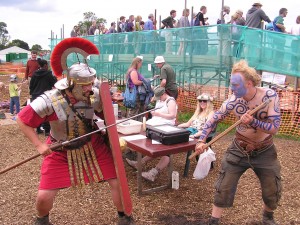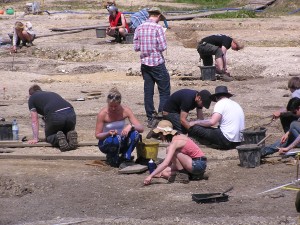Owing to the continuous heavy rain, this season’s excavations at Roman Silchester have been more challenging than ever. However, the usual festive atmosphere prevails, as was apparent 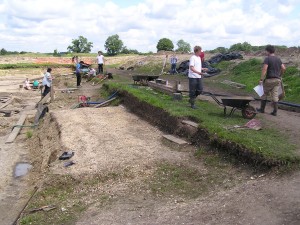 at yesterday’s Open Day, when many of the participants wore ‘themed’ costumes.
at yesterday’s Open Day, when many of the participants wore ‘themed’ costumes.
The rain has also beautifully brought out subtle but revealing contrasts in the soil, which are not so obvious on ground that has been baked dry by summer sun. For example, there are dark stripes marking the remains of floor-level beams, dark circular stains indicating post-holes, more dark stripes along the third-century street (pictured left) suggestive of wheel ruts.
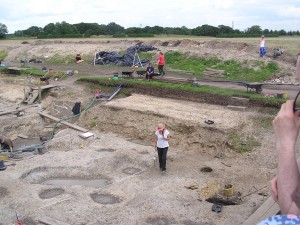 The picture on the left illustrates the progress of the archaeologists over the years from the third-century street level (behind Amanda Clarke, Field Director, in the fetching hat) down to that of the first century (on which she is standing). They are continuing to concentrate on the earliest Roman layer in Insula IX, dating more precisely from about 40 to 60 A.D., where they have discovered a large number of insubstantial wooden buildings.
The picture on the left illustrates the progress of the archaeologists over the years from the third-century street level (behind Amanda Clarke, Field Director, in the fetching hat) down to that of the first century (on which she is standing). They are continuing to concentrate on the earliest Roman layer in Insula IX, dating more precisely from about 40 to 60 A.D., where they have discovered a large number of insubstantial wooden buildings.
Michael Fulford and Amanda Clarke, who oversee the dig, remain convinced that these buildings were for military use, and indeed that the Calleva of that period was highly-militarised, if not a garrison town. As Professor Fulford has discovered in previous excavations, there was a square wooden building under the later Forum, which is equally likely to have had a military purpose. In further support of the theory, the finds in Insula IX have included horse harnesses, belts and buckles, a ballista bolt and – in the last three weeks – three tiny pieces of chain mail.
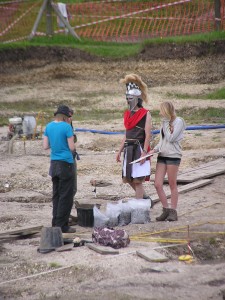 The team are also revealing further traces of the iron-age settlement that existed before the arrival of the Romans, including what may have been the hall of a chief. There is evidence beside it of a substantial track. Its route through adjoining fields is to be investigated by means of ground-penetrating radar. Where the street runs past the chief’s house it is lined by a row of post-holes. There is also a flanking trench, which was either to support a fence, or for drainage.
The team are also revealing further traces of the iron-age settlement that existed before the arrival of the Romans, including what may have been the hall of a chief. There is evidence beside it of a substantial track. Its route through adjoining fields is to be investigated by means of ground-penetrating radar. Where the street runs past the chief’s house it is lined by a row of post-holes. There is also a flanking trench, which was either to support a fence, or for drainage.
Remains of amphorae, samian-ware and goblets imported from the Continent are evidence that this was no backwater. The Atrebates enjoyed a relatively sophisticated diet, which included such exotica as dill, coriander and celery. Most exciting of all has been discovery this season, in a well, of a single olive stone, the very earliest to have been found in Britain – a Continental import before ever the Romans arrived. This is not surprising given that Commius and his Atrebates, the first-century B.C. colonisers of this place, were émigrés from Gaul.
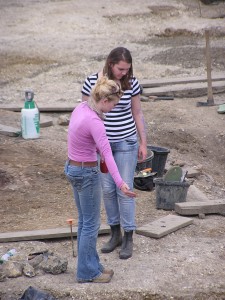 The most poignant discovery has been of a little dog in the foundations of the supposed chief’s house. An animal of two or three years old, resembling a miniature poodle, it is of a type never previously seen in Britain, a land better known for its cunning hunting dogs. Professor Fulford thinks the animal was an offering, deliberately buried in the foundations to ensure the life of the building. One wonders if it had been the cherished pet of the chiefly family – and hopes that its death was quick and painless.
The most poignant discovery has been of a little dog in the foundations of the supposed chief’s house. An animal of two or three years old, resembling a miniature poodle, it is of a type never previously seen in Britain, a land better known for its cunning hunting dogs. Professor Fulford thinks the animal was an offering, deliberately buried in the foundations to ensure the life of the building. One wonders if it had been the cherished pet of the chiefly family – and hopes that its death was quick and painless.
Pressed on the causes of Silchester’s decline in the fifth century A.D., Professor Fulford points to evidence of deliberate spoliation, with the rubble of demolished buildings having been tossed into wells. The inhabitants had a habit of digging these wells into ancient latrine pits, which cannot have helped. Whatever the causes of its gradual abandonment, the thoroughly-Romanised Calleva Atrebatum had no future in Saxon-dominated Britain.
For last year’s Silchester blogs, see http://www.rupertwilloughby.co.uk/archives/753.
